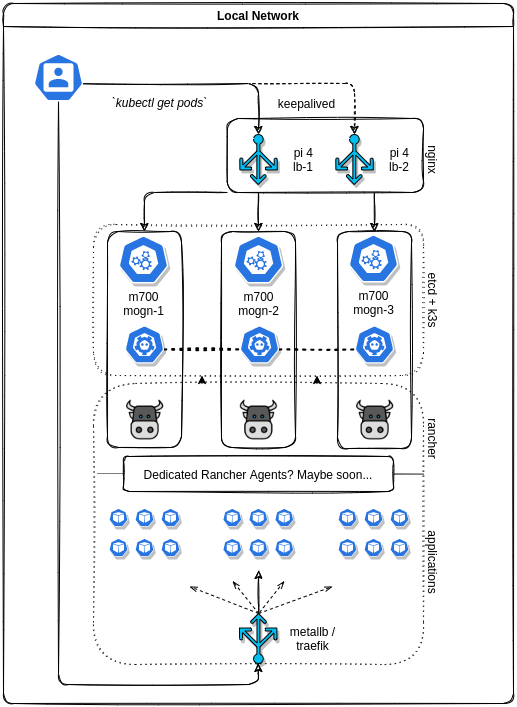Homelab cluster automation playbooks.
Configures and spins up a highly available* etcd, k3s, rancher cluster based on an arbitrary number of nodes.
*assuming a minimum of 2 server nodes and 2 load balancers

not visualized: a rancher / k3s agent role is available, I just don't have any in my cluster yet
-
a control node
-
1+ server / agent node
-
optional: 1+ external load balancer node, otherwise traefik will be used internally (ships with k3s)
-
a
hostsfile:[servers] node-1 ip=<node-1-ip> node-2 ip=<node-2-ip> node-3 ip=<node-3-ip> [agents] <- optional node-4 ip=<node-4-ip> [loadbalancers] <- optional lb-1 ip=<lb-1-ip> lb-2 ip=<lb-2-ip> -
a
vars/env.ymlfile:--- K3S_TOKEN: "<CUSTOM_TOKEN>" DNS_NAME: "<CUSTOM_DNS_NAME>" VIRTUAL_IP: "<CUSTOM_VIRTUAL_IP>" KEEPALIVED_PASSWORD: "<CUSTOM_PASSWORD>"A template for these files can be created with
ansible-playbook init.yml
ansible-playbook init.yml
Don't forget to update the values to fit your cluster.
---
ansible-playbook provision.yml
The default behavior of provision.yml is to run the kubectl.yml playbook at the end which copies and adds the kubeconfig to the local control node for access to the cluster. If you would like to skip this step append -e nokubectl=True to the command e.g:
ansible-playbook provision.yml -e nokubectl=True
source ~/.profile
kubectl get nodes
Create a DNS record or /etc/hosts entry for the load balancer or one of the rancher servers if you didn't set any up. Browse to the DNS_NAME url (e.g rancher.mogn.co) that you set in the vars/env.yml file and you should see the Rancher welcome screen.
-
Part 0 (?) - PXE boot
-
Part 1 - HA etcd- merged with 3e3fea6
-
Part 2 - HA k3s- merged with PR - k3s roles
-
Part 3 - HA rancher- merged with PR - rancher role
-
Part 4 - nginx rancher load balancer- merged with PR - nginx lb
- keepalived HA merged with PR - keepalived
-
Part 5 - TLS
-
Part 6 - traefik / metallb application load balancer